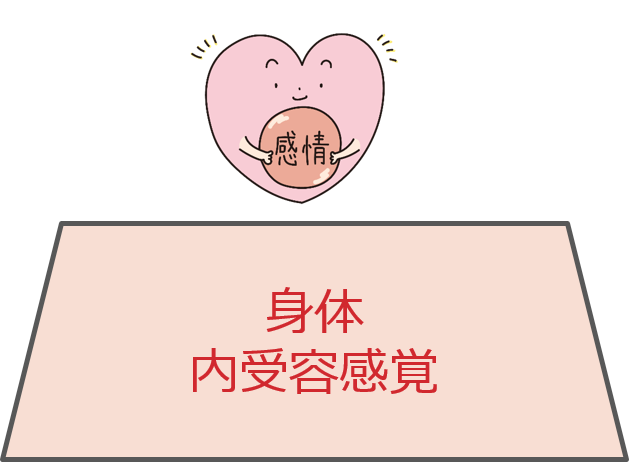Interoception is the sense of the internal state of the body.
“Emotion” and “Feeling” are functions that are fundamental to human psychological processes, such as joy, anger, sorrow, anxiety, tension, and pleasure/displeasure. These psychological processes of emotion and feeling are closely related to the interoception that captures the internal state of the body. “Emotions are rooted in the body”. Let’s explore the important relationship between emotions and interoception in psychosomatic medicine.
Emotions and Feelings
“Feeling” refers to processes of the mind, such as joy, anger, and sorrow. We experience various emotions in response to different events and situations in our daily lives.
Even animals have different emotions, such as good or bad mood, but human emotions are more varied and complex. The more complex emotions are called “higher order” emotions, while “lower order” emotions are more ambiguous, such as pleasure/displeasure, and are sometimes distinguished from feelings and called “emotions”.
[※ Terminology in this area varies among researchers, but this article follows the usage of Damasio and others].

“Emotion” is closely related to physiological functions. For example, it is difficult to distinguish between physical discomfort → fatigue → depressive feelings as to how much is physiological discomfort and how much is a psychological state. The same goes for physical tension → psychological tension or anxiety.
● Being “higher-order” implies being closer to a subjective psychological level, and
● Being “lower-order” implies being closer to a physiological or bodily level,
is the image.
As it is said that “people do not act on reason but on emotion” or “people are emotional animals”, emotions are very important in our lives. Avoiding people who evoke unpleasant emotions when they are around can lead to avoiding danger. Emotions play an important role in making important decisions such as “where to live” or “which group to belong to.”
In addition, humans are social animals and possess a high level of sociability mediated by complex feelings (higher-order emotions). Communication is extremely important in social living, and emotions/feelings also play an important role in communication.
Thus, emotions/feelings have a fundamental importance in human life, including behavior, judgment, decision-making, and communication.
Interoception as the Basis of Emotion
How does the bodily sensation of “interoception” relate to the psychological process of emotion? In recent years, there have been remarkable advances in neuroscience, and various mental functions have been elucidated in terms of which parts or networks of the brain are involved and how they are formed. It has been found that there is considerable overlap between the regions involved in emotion/feeling processing and those involved in interoception. In particular, a region of the brain called the “insula” is said to play a central role in both.
Emotions experienced in various situations in daily life. What influences those emotions?.
First, external situations and contexts influence emotions. Positive emotions arise when praised by others, while negative emotions arise when criticized.
In addition, sensory information such as the five senses accompanying it also influences emotions. In a park surrounded by nature and a calm atmosphere, you are likely to feel good and positive emotions such as joy are more likely to arise, and the scent of trees and flowers (olfactory information) also induces positive emotions. Conversely, seeing or hearing unpleasant people’s voices or actions will evoke negative moods and emotions.

Another major factor is one’s internal bodily state. It is common for irritability and anxiety to occur more easily with the menstrual cycle in women. Even if the same thing is said by the same person, the emotions experienced vary greatly depending on whether one’s physical condition is good or bad. When physically fit, positive emotions are more likely to arise from a cheerful mood, whereas when physically unwell, mood also declines, making negative emotions more likely to arise.
In this way, while external situations and internal states largely influence emotions, it is also believed that emotions arise from sensory information at the level of sensation,
(1) sensory information from the external environment “exteroception” and
(2) sensory information from internal states “interoception”.
The integration of these exteroception and interoception is believed to occur in the aforementioned region of the brain called the insula.
Although there are different opinions on the distinction between exteroception and interoception, it can be said that a strict distinction is difficult. This is because internal states change depending on external situations, and the perception of external situations also changes depending on internal states, creating a mixed and integrated whole. Some perspectives include exteroception in interoception. Furthermore, emotions are strictly internal experiences and are only communicated to others through words or expressions.
Taking all these factors into account, it can be said that interoception serves as the basis for emotion formation.
Emotions are rooted in the Body
With interoception as the foundation of the psychological process of emotion, “emotions are rooted in the body”. What does this mean in psychosomatic medicine and clinical medicine?
One important point is that since the body is fundamentally involved in emotions (and higher-level psychological processes), the assessment of bodily state is essential in mental health and emotion management, and regulation of interoception is key.
It has been a long time since the term “stress society” was coined, and with the rapid development of AI, stress management and mental health have become increasingly important, but focusing on the psychological aspect “alone” and providing counseling and other services risks being one-sided.
It is sometimes experienced in the medical practice of psychosomatic medicine that although psychological problems are thought to be the main issue and attention is focused on them, the condition does not improve easily, and it turns out that physical problems were overlooked.
For example, in the case of a middle-aged woman with symptoms of depression or panic attacks, it was thought that psychological issues such as family relationships were largely involved, but in fact there was an abnormality in female hormone levels and the influence of menopausal symptoms was significant. Once that improved, the psychological situation became less problematic.

Inseparable Mind and Body
Even if it doesn’t reach the level of physical illness, there are various fluctuations in physical condition. Since mental states vary depending on whether the physical condition is good or bad, it is necessary to manage the physical condition together for mental health management.
Conversely, psychological problems can also affect physical health. There are cases where psychological problems that the person is not aware of are behind persistent physical symptoms such as pain, and despite various medical tests, no abnormalities are found and treatments such as medication do not work. In such cases, improvement has been achieved through psychological approaches.
When we say that “emotions are rooted in the body,” we tend to think that the body => emotion (mind), but there is also the effect of emotion on the body. In fact, brain science has confirmed that the internal receptive sensory system is a bidirectional system, involving not only afferent (peripheral to central) functions, but also efferent (central to peripheral) functions to a large extent.
Understanding the close relationship between “mind and body” is important. And when interoception becomes appropriate, it becomes easier to notice one’s own state, such as feeling tired, and early intervention becomes possible. This is the key to surviving the “stress society” and has significant implications for the treatment of stress-related disorders.
(Kanbara K, LABs Psychosomatic Medicine, https://psychosom.net/en/column/interoception3, Oct 2023)
Related Columns, Articles, and Research
- Interoception and Psychosomatic Medicine
- Interoception and Psychosomatic Medicine (2)
- Alexithymia
- Research: Psychosomatic Research on Interoception
- Research: Psychosomatic Monitoring and Stress Assessment in Daily Life: The Key is Interoceptive Awareness
- Research: Emotional Process and Autonomic Function
References
Kanbara, K., Fukunaga, M. Links among emotional awareness, somatic awareness and autonomic homeostatic processing. BioPsychoSocial Med 10, 16 (2016). https://doi.org/10.1186/s13030-016-0059-3
